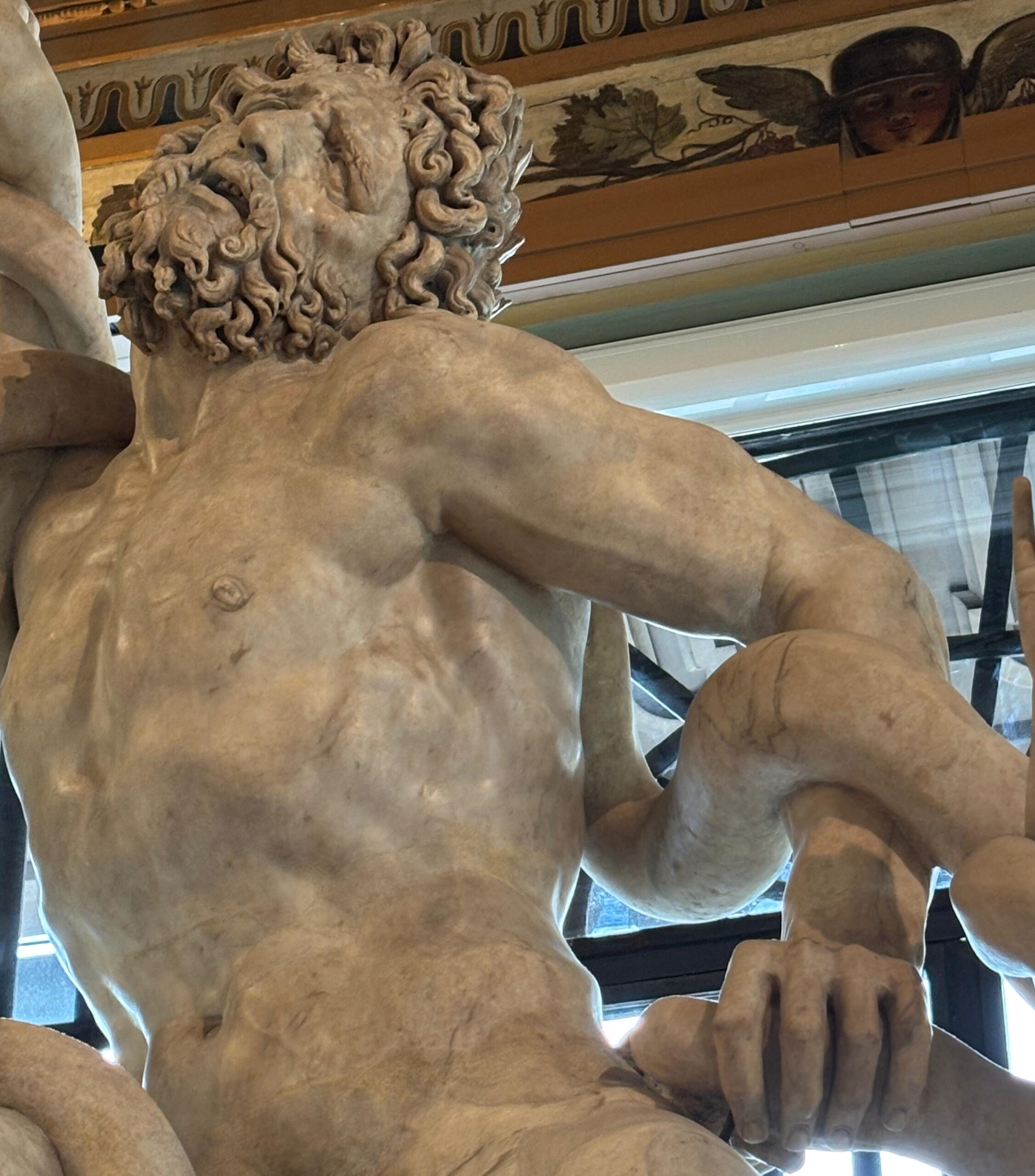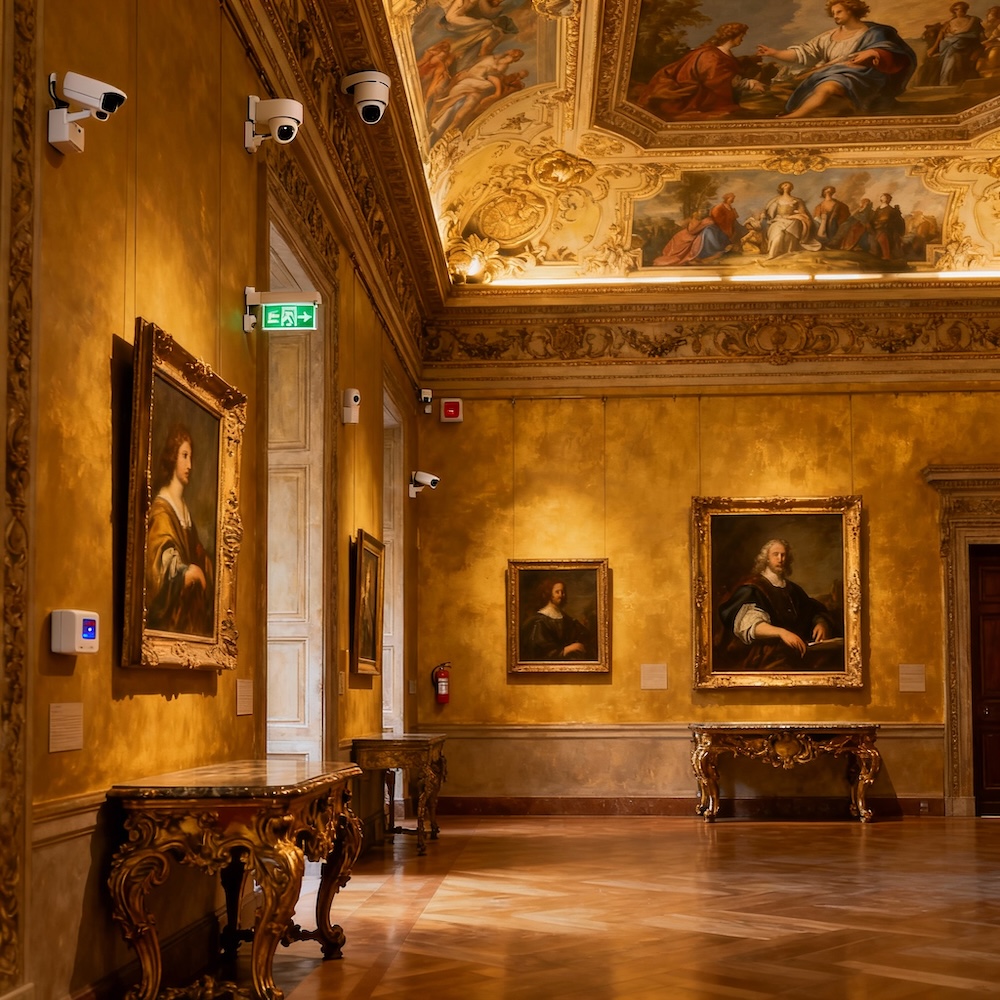Protecting Marble Artworks: What a 1762 Fire Can Teach Us
On August 12, 1762, a fire broke out in the third corridor of the Uffizi Gallery, causing the collapse of the roof and inflicting severe damage to several artworks—including the renowned Laocoön sculpture (this group depicting Laocoon, should not be confused with the one in the Vatican Museums, in Rome, from which Baccio Bandinelli took inspiration for the statue present in the Uffizi Gallery).
The heat and fumes fractured the marble into dozens of pieces and left lasting stains and alterations on the stone surface.

Although restoration began shortly after the event (completed in 1766 by Traballesi), the long-term effects of fire on marble—such as internal microfractures, surface discoloration, and patina loss—have only recently been fully understood thanks to advanced diagnostic techniques including UV fluorescence photography, FT-IR spectroscopy, and laser cleaning technologies.
The Laocoön was recently restored again, revealing parallel fractures, wax deposits, and historical stucco integrations. Much of this damage directly traces back to the 1762 fire, highlighting the enduring vulnerability of marble to thermal shock and smoke exposure.
This case underlines a crucial consideration for fire safety professionals: fire exposure can irreversibly compromise the structural and aesthetic integrity of stone artworks, significantly increasing restoration time and cost.
Immediate and Long-Term Damage to Marble from Fire
Marble, primarily composed of calcite crystals, is particularly susceptible to fire due to its thermal anisotropic dilatation. When heated, calcite crystals expand along the c-axis and contract in other crystallographic directions.
Immediate Impacts:
- Microcracking and Structural Changes: Temperatures above 200 °C can induce significant microcracking in marble. The critical temperature range for considerable loss of mechanical strength in marble is typically between 400 and 800 °C. Up to around 600 °C, damage is mainly influenced by the anisotropic thermal expansion of calcite.
- Calcination and Spalling: At higher temperatures (above 600 °C), marble undergoes severe structural and chemical changes as calcite decomposes into calcium oxide and carbon dioxide, a process that accelerates beyond 800 °C. This calcination, and the subsequent hydration of calcium oxide to calcium hydroxide, involves significant volume changes, intensely affecting the stone’s structure and potentially leading to spalling of outer surface layers or even crumbling into powder. Dense materials like marble are prone to physical breakdown due to micro-cracking caused by mineral thermal expansion and the absence of a matrix to absorb these stresses.
- Discoloration: Fire can cause discoloration due to thermal oxidation of iron-bearing minerals, which can begin at temperatures as low as 250–300°C. This may not compromise structural stability but can lead to extreme aesthetic damage.
Lingering Legacies and Long-Term Effects:
- Stress Legacy: Fire can leave a “stress legacy” that may be exploited by other, less extreme decay processes over many years.
- Altered Permeability and Decay: The altered structure can lead to increased porosity. After the initial soot layer detaches (or is cleaned), the newly exposed surface may exhibit rapid granular disaggregation due to the alteration of the stone matrix by extreme heat, making it more permeable and susceptible to further decay, such as salt weathering.
- Progressive Material Loss: Even years after the fire, sculptures can experience noticeable progressive material loss, as observed in some Bode Museum sculptures between 2015 and 2022.
- Continued Deterioration: Without proper condition assessment and intervention, fire-damaged sculptures may continue to deteriorate.
The Role of Combustion Products
Beyond direct heat, combustion by-products pose significant threats to marble:
- Soot and Staining: Smoke and soot adhere to stone surfaces, staining them and potentially affecting permeability. This blackening is an obvious immediate surface effect.
- Chemical Alteration: Fumes and ashes introduce new elements such as carbon, sulfur, nitrogen, phosphorus, and organic compounds like oils and waxes. These can coat stone surfaces and fill near-surface pores.
- Salt Formation: The combination of these introduced elements with alteration products from the stone, especially when wetted during fire extinguishing, can generate harmful salts (e.g., sulfates, nitrates, phosphates). If the stone becomes saturated, these salts can be transported throughout a block, causing severe damage upon drying as they crystallize. A patchy soot cover can also promote surface heterogeneities, leading to flaking when salts concentrate behind the less permeable crust.
Restoration and Conservation Strategies
Effective conservation of fire-damaged stone, particularly significant artworks like the Bode Museum sculptures, necessitates a comprehensive and careful assessment of their condition.
Assessment and Monitoring:
- Non-destructive Ultrasonic Technique: This is considered one of the best methods for assessing marble objects due to its effectiveness, ease, speed, and non-destructive nature, which is crucial for art objects. It measures the velocity of ultrasonic waves, which correlates with the stone’s deterioration state, mechanical strength, and the presence of cracks.
- Damage Classification: An improved classification system, based on ultrasonic velocity measurements, allows for categorizing marble damage (e.g., sound, increasing porosity, granular disintegration, danger of breakdown, complete structural damage). The average ultrasonic velocity for the assessed Bode Museum sculptures indicated an advanced damage level, typically “danger of breakdown”.
- Visual Examination: Simple visual examination complements ultrasonic measurements, identifying visible damage like cracks, material loss, and discoloration.
- Regular Monitoring: Regular condition monitoring through periodic ultrasonic velocity measurements (e.g., every five to ten years) is essential to track deterioration and evaluate conservation effectiveness.
Interventive and Preventive Conservation:
- Structural Consolidation: Interventive structural treatments are indispensable, especially for areas exhibiting severe damage (classes 4 and 5, corresponding to danger of breakdown and complete structural damage). This includes consolidation of weak and fragile parts (e.g., areas with ultrasonic velocity below 3 km/s) and stabilization of heavily loaded sections. The choice of consolidation material and application method must be carefully considered to avoid adverse effects.
- Fire Suppression Systems: Fire suppression strategies should be appropriate for historic stone buildings. Water misting or fogging systems are recommended over traditional water-based firefighting methods, as they minimize damage to stone surfaces. Abrupt cooling from large amounts of cold water can cause spalling, especially in dense, significantly heated stones like marble.
- Preventive Measures: These include regular maintenance, protection against sharp fluctuations in climatic conditions, and mitigation of shocks and vibrations. Minimizing movement and transportation of sculptures, and careful handling of damaged areas, are also vital.
- Prioritizing Structural Stability: Decisions regarding aesthetic treatments (cleaning, stain removal, reconstruction of missing parts) should be made carefully. It may be safer to defer these until structural consolidation and strengthening are complete, as premature aesthetic work could compromise stability.
Conclusions
Fire poses a profound and complex threat to marble cultural heritage. The studies highlighted underscore the critical need for a thorough understanding of how marble reacts to heat and combustion by-products, both immediately and over time. By utilizing advanced non-destructive assessment techniques like ultrasonics and implementing tailored conservation and fire suppression strategies, we can better protect these invaluable historical artifacts for future generations. Each case, and indeed each stone block, has a unique stress history, emphasizing that post-fire management should be informed by targeted research and continuous monitoring rather than generalities.
In performance-based fire risk assessment methods, such as those used for cultural heritage sites, these long-term consequences must be factored into the risk analysis—not only in terms of immediate fire suppression needs but also in terms of post-incident conservation challenges.
When protecting cultural heritage, the goal is not just to prevent loss of life or complete destruction, but to minimize irreversible material degradation and ensure long-term preservation.
In conclusion, fire safety strategies should be not only technically robust but also deeply informed by the vulnerabilities of the artworks themselves.
Sources
Impacts of Fire on Stone-Built Heritage An Overview -M. Gomez-Heras, S. McCabe, B. J. Smith, R. Fort
Condition assessment of two fire-damaged historical marble sculptures from Bode Museum in berlin by nondestructive ultrasonic technique – A. Ahmad, S. Simon




